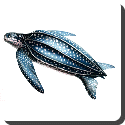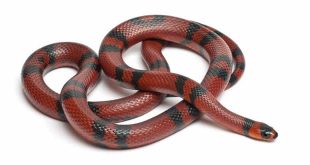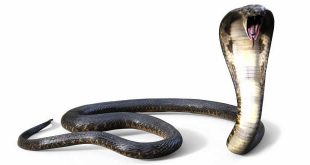 Leatherback Turtle — The leatherback turtle (Dermochelys coriacea) is the largest of all living turtles. It is the only living species in the genus Dermochelys. As a sea turtle, the leatherback is the largest and heaviest. It can easily be differentiated from other modern sea turtles by its lack of a shell. Instead, the carapace of the leatherback turtle is covered by skin and the turtle’s oily flesh. D. coriacea is the only extant member of the Family Dermochelyidae.
Leatherback Turtle — The leatherback turtle (Dermochelys coriacea) is the largest of all living turtles. It is the only living species in the genus Dermochelys. As a sea turtle, the leatherback is the largest and heaviest. It can easily be differentiated from other modern sea turtles by its lack of a shell. Instead, the carapace of the leatherback turtle is covered by skin and the turtle’s oily flesh. D. coriacea is the only extant member of the Family Dermochelyidae.
Leatherback turtles follow the general sea turtle body plan of having a large, dorsoventrally flattened, round body with two pairs of appendages, a large head and a short tail. Like other sea turtles, the leatherback’s flattened forelimbs are specially adapted for swimming in the open ocean. Claws are noticeably absent from both pair of flippers. The leatherback’s flippers are the largest in proportion to its body among the extant sea turtles. Leatherback front flippers can grow up to 270 centimeters in large specimens. As the last surviving member of its family, the leatherback turtle has several distinguishing characteristics that differentiate it from other sea turtles. Its most notable feature is that it lacks the bony carapace of the other extant sea turtles. Instead of scutes, the leatherback’s carapace is covered by its thick, leathery skin with embedded minuscule bony plates. Seven distinct ridges arise from the carapace, running from the anterior-to-posterior margin of the turtle’s back. The entire turtle’s dorsal surface is colored dark grey to black with a sporadic scattering of white blotches and spots.
The leatherback turtle is a species with a cosmopolitan global range. Of all the extant sea turtle species, D. coriacea has the widest distribution, reaching as far north as Alaska and Norway and as far south as the Cape of Good Hope in Africa and the southernmost tip of New Zealand. The leatherback is found in all tropical and subtropical oceans, and its range has been known to extend well into the Arctic Circle. Globally, there are three major, genetically-distinct populations. The Atlantic Dermochelys population is separate from the ones in the Eastern and Western Pacific, which are also distinct from each other. A third possible Pacific subpopulation has been proposed, specifically the leatherback turtles nesting in Malaysia. This subpopulation however, has almost been eradicated. While specific nesting beaches have been identified in the region, leatherback populations in the Indian Ocean remain generally unassessed and unevaluated.
 Kids Portal For Parents India Kids Network
Kids Portal For Parents India Kids Network


